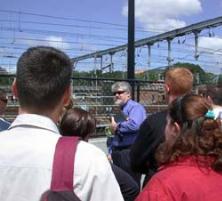Diploma in Railway Signalling first of its type in the world
Published on 19 May, 2004
A postgraduate Diploma in Railway Signalling developed via a Rail CRC project and offered by Central Queensland University under license is the first available to the signalling profession anywhere in the world.
That is according to Associate Professor Ken Kwong, from Central Queensland University, who has coordinated development of the project as well as the program offering.
Associate Professor Kwong said the inaugural intake for the distance mode program had been limited to 30 students who reside in Australia. Interest had been shown from all mainland states and overseas.
 "The program has been developed by the joint effort of a University (CQU), members of a professional institution (IRSE), and CRC industry partners, all of whom are contributing their intellectual property and state-of-art know-how to the project as contribution-in-kind," he said.
"The program has been developed by the joint effort of a University (CQU), members of a professional institution (IRSE), and CRC industry partners, all of whom are contributing their intellectual property and state-of-art know-how to the project as contribution-in-kind," he said.
"The product has wide support from the employers of this sector of the rail industry. These organisations, besides sponsoring their employees to enrol in the program, also provided work-based support and the service of work-based mentors from their senior staff. Several organisations have embedded the enrolment in this program as an integral part of their graduate engineer development.
"The program will seek accreditation from the Institution of Railway Signal Engineers (IRSE), which is the professional body representing around 4000 members currently practicing worldwide." Associate Professor Kwong said the program was developed primarily by industry to meet pressing industry needs. The Rail CRC has acted as the catalyst as well as providing some cash funding to make it all possible.
He said the structured education program extended from pure technical know-how to include broad understanding of the current business, legal and social environment that the railway industry must work in.
"It uses a combination of technology and human interaction to promote collaborative learning and networking among students over a geographically dispersed area, and from a variety of organisations," he said.
"E-learning is supported by a course web site and multimedia CDs for each course. Teamwork amongst students is specified as a key-learning goal for the program. Students met face-to-face and with members of the teaching team for a 2-day induction program before they started the course. Three of the class members were flown back to Australia specifically from Malaysia by their employer to attend this induction.
"The program is designed with project-based learning (PBL) and work-integrated learning as a goal. It enlists the help of work-based mentors who direct students’ application of theory to local practices. The mentors also act as local tutors in an honorary capacity to supplement university teaching staff." Associate Professor Kwong said the rail industry and Institution of Engineers, Australia through the RTSA, had identified a strong need for this type of program over a period of several years.
"Three projects have been initiated from RailCRC Theme 6 Education & Training, addressing the areas of railway signalling, railway civil infrastructure and rollingstock. The program for railway signalling is the first one to have reached commercialisation stage," he said. ENDS Photo: A field visit to inspect various railway signalling infrastructures was organised as part of the 2-day induction program in February, 2004.

